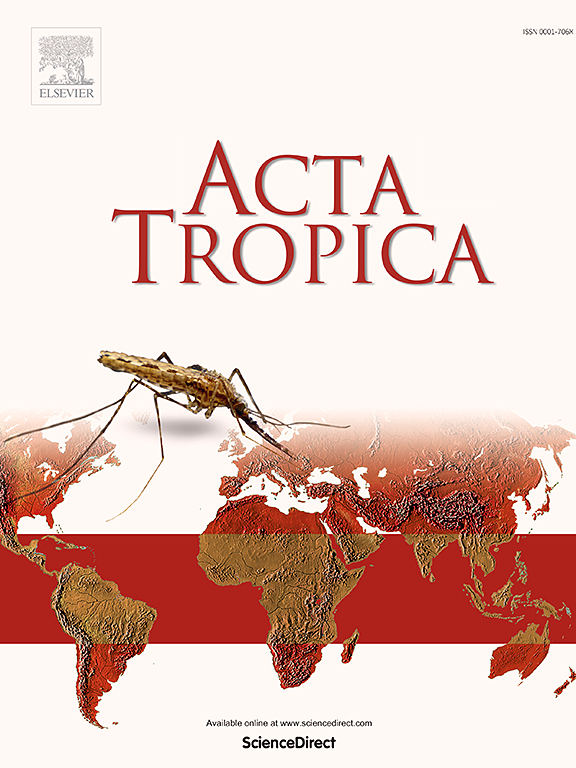Proteophosphoglycan functional motifs display genetic polymorphism in a natural population of Leishmania (Viannia) braziliensis
IF 2.1
3区 医学
Q2 PARASITOLOGY
引用次数: 0
Abstract
Leishmaniasis causes 3.5 M DALYs. Treatment often requires parenteral administration and causes debilitating side effects. Vaccines to prevent the most dramatic outcomes would be most welcome. The Proteophosphoglycan (PPG) is encoded by ppg1 to ppg4 and mediates interaction of Leishmania spp. with macrophages employing two motifs: leucine-rich (LRR), and alanine, proline, and serine repeats (APS). We PCR amplified, cloned, sequenced, and assessed the conservation of LRR and APS of ppg3 and ppg4 in L. braziliensis of 24 patients from Northeast Brazil, then compared them to Leishmania spp. from Genebank. Evolutionary divergencies (ED) between ppg alleles were calculated by Maximum Composite Likelihood. The amplification success of ppg3-lrr was 87.5 %; ppg3-aps was 58.3 %; and ppg4-lrr was 62.5 %. ppg3-lrr presented two conserved alleles of equal frequencies, similar to reference strain's (ED = 0.000). ppg4-lrr presented three alleles with overall lower conservation (ED = 48.820). Conservation was high for two of the alleles (ED = 0.003) present in 87.5 % of isolates. Three alleles of ppg3-aps were observed (overall ED = 0.730). One occurred in three L. braziliensis isolates being similar to reference strain's (ED = 0.009). The other two were present in 70 % of the isolates, substantially deviating from the reference L. braziliensis (ED > 1.000). Phylogeny employing ppg3-lrr, ppg3-aps or ppg4-lrr clustered L. braziliensis reference and test isolates with the other subgenus Viannia species, segregating them from species of other New and Old-World subgenera. Overall, moderate polymorphism affected functional PPG motifs, opening the possibility of their consideration in eventual subunit vaccines against leishmaniasis.

巴西利什曼原虫自然种群中蛋白磷酸聚糖功能基元显示遗传多态性。
利什曼病导致3500万人死亡。治疗通常需要肠外注射,并导致虚弱的副作用。预防最严重后果的疫苗将是最受欢迎的。蛋白磷酸聚糖(PPG)由ppg1至ppg4编码,通过富含亮氨酸(LRR)和丙氨酸、脯氨酸和丝氨酸重复序列(APS)两种基序介导利什曼原虫与巨噬细胞的相互作用。我们对来自巴西东北部的24例巴西L. brasiliensis的ppg3和ppg4的LRR和APS进行了PCR扩增、克隆、测序和评估,并将其与Genebank中的利什曼原虫进行了比较。利用最大复合似然法计算ppg等位基因间的进化差异。ppg3-lrr扩增成功率为87.5%;Ppg3-aps为58.3%;ppg4-lrr为62.5%。ppg3-lrr与参考菌株相似,存在两个频率相等的保守等位基因(ED = 0.000)。ppg4-lrr有三个等位基因总体保守性较低(ED = 48.820)。87.5%的分离株中有2个等位基因(ED = 0.003)具有较高的保守性。ppg3-aps共有3个等位基因(总ED = 0.730)。其中1例发生在3株巴西乳杆菌中,与参考菌株相似(ED = 0.009)。另外两种菌株存在于70%的分离株中,与参考菌株巴西乳杆菌(edbbb1.000)有很大差异。利用ppg3-lrr、ppg3-aps或ppg4-lrr聚类巴西l.b lailiensis参考和测试菌株与其他Viannia亚属的种,将它们与其他新、旧大陆亚属的种分离开来。总的来说,适度的多态性影响功能性PPG基序,开启了在最终抗利什曼病亚单位疫苗中考虑它们的可能性。
本文章由计算机程序翻译,如有差异,请以英文原文为准。
求助全文
约1分钟内获得全文
求助全文
来源期刊

Acta tropica
医学-寄生虫学
CiteScore
5.40
自引率
11.10%
发文量
383
审稿时长
37 days
期刊介绍:
Acta Tropica, is an international journal on infectious diseases that covers public health sciences and biomedical research with particular emphasis on topics relevant to human and animal health in the tropics and the subtropics.
 求助内容:
求助内容: 应助结果提醒方式:
应助结果提醒方式:


